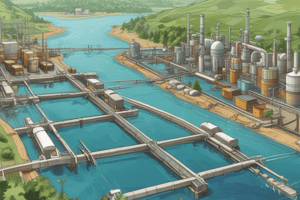Podcast
Questions and Answers
What is the reason for decrease in dissolved oxygen levels in surface water during summer?
What is the reason for decrease in dissolved oxygen levels in surface water during summer?
- Decrease in biochemical reactions
- Increase in wastewater temperature (correct)
- Increase in oxygen quantity
- Decrease in specific heat of water
At what temperature do aerobic digestion and nitrification stop?
At what temperature do aerobic digestion and nitrification stop?
- 45°C
- 50°C (correct)
- 40°C
- 55°C
What percentage of wastewater is composed of water?
What percentage of wastewater is composed of water?
- 95%
- 99.9% (correct)
- 99%
- 90%
What is the percentage of settleable suspended solids in municipal wastewater?
What is the percentage of settleable suspended solids in municipal wastewater?
What is the purpose of measuring organic matter?
What is the purpose of measuring organic matter?
What does TOC measure in wastewater?
What does TOC measure in wastewater?
What is the term used to describe the sum of nitrate-nitrogen, nitrite-nitrogen, ammonia-nitrogen, and organically bonded nitrogen?
What is the term used to describe the sum of nitrate-nitrogen, nitrite-nitrogen, ammonia-nitrogen, and organically bonded nitrogen?
Which of the following is a characteristic of heavy metals?
Which of the following is a characteristic of heavy metals?
What is the term used to describe the sum of phosphorus forms?
What is the term used to describe the sum of phosphorus forms?
What type of organism is commonly found in wastewater?
What type of organism is commonly found in wastewater?
What is the term used to describe the toxicity of a substance?
What is the term used to describe the toxicity of a substance?
What is the most important physical characteristic of wastewater?
What is the most important physical characteristic of wastewater?
What is the typical colour of fresh wastewater?
What is the typical colour of fresh wastewater?
What is the cause of odour in wastewater?
What is the cause of odour in wastewater?
Why is temperature an important parameter in wastewater?
Why is temperature an important parameter in wastewater?
What is the colour of wastewater that has undergone anaerobic conditions?
What is the colour of wastewater that has undergone anaerobic conditions?
What is the relationship between the temperature of wastewater and that of water supply?
What is the relationship between the temperature of wastewater and that of water supply?
Study Notes
Wastewater Characteristics
- Wastewater has a higher temperature than air, which can lead to increased biochemical reactions and decreased oxygen levels in surface water, causing serious depletions in dissolved oxygen levels.
- Aerobic digestion and nitrification stop when the temperature rises above 50°C.
Physical Characteristics of Wastewater
- Wastewater contains a variety of solids, including rags, colloidal material, and others.
- Sewage is comprised of 99.9% water and 0.1% solids.
- Typically, 60% of suspended solids in municipal wastewater are settleable.
- Solid fractions present in wastewater include TS, TVS, TFS, TSS, VSS, and others.
Chemical Characteristics of Wastewater
- Organic matter measurement is crucial in wastewater treatment plant design and operation, water quality management, and understanding wastewater microbiology.
- Organic matter can be biodegradable or non-biodegradable.
Organic Pollution Parameters
- BOD (Biochemical Oxygen Demand) measures the oxygen utilized for the biochemical degradation of organic material.
- COD (Chemical Oxygen Demand) measures the content of organic matter that can be oxidized by a specified chemical reagent.
- TOC (Total Organic Carbon) measures the carbon content.
- BOD, COD, and TOC are referred to as "total phosphorus (as P)".
Nutrients in Wastewater
- Total Nitrogen (TN) is the sum of nitrate-nitrogen, nitrite-nitrogen, ammonia-nitrogen, and organically bonded nitrogen.
- TN is sometimes regulated as an effluent parameter for industrial wastewater treatment plants.
Heavy Metals in Wastewater
- Heavy metals include arsenic, cadmium, chromium, mercury, and lead.
- Heavy metals are toxic and carcinogenic agents that pollute waters and sediments in marine and aquatic ecosystems.
- They pose a serious threat to human population and the fauna and flora of the receiving water bodies.
Biological Characteristics of Wastewater
- Wastewater contains biological components such as coliforms, bacteria, viruses, and protozoa.
- Toxicity is a significant concern in wastewater composition.
Physical Characteristics of Wastewater (continued)
- Important physical characteristics of wastewater include turbidity, color, temperature, conductivity, density, and specific gravity.
- The most important physical characteristic of wastewater is its solids.
- Color: Fresh wastewater is grey in color, which changes to black as the travel time in the collection system increases and anaerobic conditions develop.
- Odor: Odor is caused by gases produced by the decomposition of organic matter, and changes from a kerosene-like smell to a stronger smell as the wastewater ages.
- Temperature: The temperature of wastewater is commonly higher than that of water supply, and affects chemical reaction rates and aquatic life.
Studying That Suits You
Use AI to generate personalized quizzes and flashcards to suit your learning preferences.
Description
Learn about the effects of temperature on wastewater treatment processes, including biochemical reactions, oxygen levels, and physical characteristics of wastewater.




